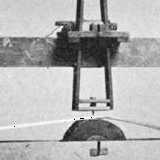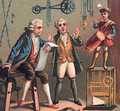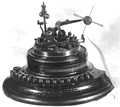The Precursors
The origins of recorded sound can be traced as far back as ancient Greeks. The colossal "vocal" statue of Memnon at Thebes was built about 1500 B.C. with the ability to make the sound of a harpstring every day to greet Memnon's mother, the Goddess of the Dawn. The secret of this sound was lost when the original statue was destroyed in 27 A.D. by earthquake.
The wheel was the first mechanism used to record sound, with pegs positioned to strike chimes as the wheel was rotated by hand. In the Middle Ages, music was reproduced by cylinders with attached pins that would strike certain keys or bells when rotated. Automatic carillons were built in the 14th century and the oldest surviving barrel organ dates from 1502 (Ord-Hume 1978). Renaissance Europe was fascinated with automata, or automatic music boxes that used elaborate clockwork gears to produce motions and sounds.
The most famous automata was a mechanical duck by Jacques de Vaucanson in 1745 that flapped its wings, raised up on its legs, stretched its neck, and moved its intestines that were visible from the outside.
Influenced by Vaucanson, and by the flood of new inventions from the Industrial Revolution, the French silk-weaver Joseph Marie Jacquard was awarded a medal at the Paris Exhibition of 1801 for an improved automatic loom. In 1804 he added punched cards to "record" a complex pattern for textiles weaved by a loom with controls connected to spring-loaded keys (see pictures of Jacquard's Punched Card). The long punched-card strips held down the keys until a hole allowed a key to open and start a loom operation. The weavers of Lyons burned Jacquard's loom in 1808 (where his statue is now located in Lyons), but Napoleon recognized its significance and awarded Jacquard a pension and royalties. The punched card was adapted by music instrument designers such as Charles Dawson who exhibited a "jacquard organ" at the London Exhibition of 1851 that used cardboard strips to control the air bellows (Ord-Hume 1984, pp. 80-81). The first use of the word "phonograph" was by F. B. Fenby in an 1863 British patent to describe a device to record a keyboard sequence on paper tape, but no model or workable device was made. From this technology of punched paper would come the player piano of the 1880s, and Herman Hollerith's punch card tabulator for the 1890 census, a precursor of the modern computer.
After the wheel and the card, electricity was a second method of recording sound. Samuel F. B. Morse designed a telegraph during an ocean voyage on the Sully in October and November, 1832.
His first device built in 1835 used a pencil and paper tape to record electric signals transmitted by a "portrule" metal bar device.  1837 telegraph 1837 telegraph |
The portrule was like the barrel organ; teeth represented digits that would be used to reconstruct words. The original code for the digit "1" was a single dot, represented on the portrule as a single tooth. The code for the digit "6" was a dot followed by a dash, represented on the portrule as a single tooth followed by an empty space. The teeth were loaded into the portrule like movable type. When the teeth touched a contact point, an electrical current went to the receiver where an electromagnet suspended from a canvas-stretcher frame moved a pencil, recording a wavy line on paper tape that corresponded to the teeth opening and breaking the circuit. By 1838, Morse developed a new code with dots and dashes representing letters rather than digits. His associate Arthur Vail replace the portrule with a hand-operated key that reproduced the code by means of a pattern of clicks. The Morse code and Vail key was used to inaugurate the first commercial telegraph line between Washington and Baltimore on 24 May 1844 with the clicks for "What hath God wrought!" (from Numbers 23:23). Telegraph operators quickly learned to send and receive soley from the sound of the clicks rather than use paper tape. Morse was not the first to invent a telegraph, but he is known as the "father" of the telegraph because he created a new industry. Hiram Sibley and Ezra Cornell would make Western Union into one of the most influential corporate empires in American history.
The electric telegraph was the stimulus for inventors to search for better methods of sending and recording all kinds
of messages, including voice and music. David E. Hughes, a Professor of Music at St. Joseph's College in Kentucky, invented in 1855 a keyboard telegraph with rotating type-wheel printer that grew into the modern telex industry. (Bray 1995 p. 43) In Germany, telegraph printers were patented as early as 1848 and Philip Reis invented an acoustic transmitter in 1861 that used a diaphragm to open and close an electrical circuit. He called it a "telephone" hoping to use it to reproduce speech and music but was unsuccessful. Elisha Gray and his Western Electric Company in Chicago had also invented an improved telegraph receiver, calling it a "telephone" after 1874 because it produced a wide range of sounds, but failed make a similar transmitter. Thomas Edison began his career as an inventor by developing recording devices. His first patent in 1869 was an electrical vote recorder and his first research lab in Newark began in 1871 as a shop to make stock tickers for Western Union. It is here that Edison hired his key assistants such as John Kruesi, Charles Batchelor and John Ott. They would help him make the electric pen in 1874 that was sold to A.B. Dick Co. of Chicago and marketed as the mimeograph machine.  Leon Scott's phonautograph about 1857, from the Smithsonian Leon Scott's phonautograph about 1857, from the Smithsonian |
Edison was influenced by the work of other inventors who had been trying to record sound. Edouard-Leon Scott de Martinville in Paris made a "phonautograph" in 1857 to trace sound waves on a carbonized cylinder with a stylus attached to a diaphragm that vibrated from spoken sounds. This device did not record the sound itself, only a graphical image of sound. Herman Helmholtz made an electric tuning-fork "sounder" device that used an electromagnetic coil, tuning fork and cardboard tube "resonator" to amplify the sound. His purpose was the scientific study of sound that was published in the influential 1862 book Senasations of Tone. Alexander Graham Bell had tried to develop a harmonic telegraph capable of sending multiple messages and accidently discovered the principle of the telephone in 1876 that used an electromagnet to vibrate a diaphragm. In 1877 Charles Cros deposited in Paris a description of a phonograph device but never built a model. Edison was seeking to improve the telephone in 1877 when he discovered the recording device known as the phonograph.
References:
- Alexander Graham Bell on the Web
- Bedini, S.A. "The Role of Automata in the History of Technology." Technology and Culture 5, 1964, pp. 24-42.
- Bowers, Q. David. Encyclopedia of Automatic Instruments. New York: Vestal Press, 1972.
- Bray, John. The Communications Miracle: The Telecommunications Pioneers from Morse to the Information Superhighway. New York: Plenum, 1995.
- Bruce, Robert V. Alexander Graham Bell and the Conquest of Solitude. Boston: Little, Brown, 1973.
- Chapuis, Alfred and Edmond Droz. Automata. New York: 1958. - has photo of Vaucanson's famous duck.
- Coe, Lewis. The Telegraph: A History of Morse's Invention and Its Predecessors in the United States. Jefferson, North Carolina: McFarland, 1993.
- Gorman, Michael. Alexander Graham Bell's Path to the Telephone. University of Virginia. 31 October 1995.
- Helmholtz, Hermann von. On the Sensations of Tone as a Physiological Basis for the Theory of Music. New York, Dover Publications, 1954.
- Josephson, Matthew. Edison, a Biography.
- Ord-Hume, Arthur W. J. G. Barrel Organ. London: Allen and Unwin, 1978.
- Ord-Hume, Arthur W. J. G. Pianola. London: Allen and Unwin, 1984.
- Thompson, Robert L. Wiring a Continent; the History of the Telegraph Industry in the United States, 1832-1866. New York, Arno Press, 1947, 1972.
- Vaucanson, Jacques de. An Account of the Mechanism of an Automaton or Image Playing on the Germna-Flute. Translated by J. T. Desaguliers. London: 1742.
- Western Union Company History, 1999.
© 1999-2003 by Steven E. Schoenherr. All rights reserved.
|
Return to Recording Technology History | revised 2/1/03 by Schoenherr




